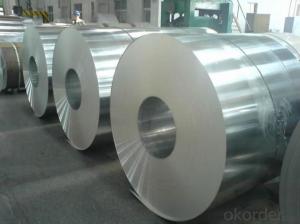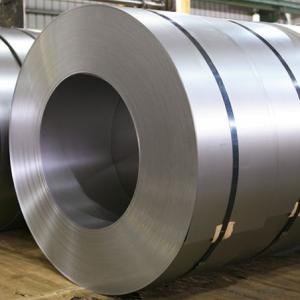Stainless Steel Coil 304 Cold Rolled 2B Finish
OKorder Service Pledge
OKorder Financial Service
You Might Also Like
Stainless Steel Coil 304 Cold Rolled 2B Finish
Packaging Detail:standard export packing or as customer's requirements
Delivery Detail:7-15 days after the order
MOQ: 100mt
Standard: | AISI,ASTM,BS,DIN,GB,JIS | Grade: | 304 | Thickness: | 0.3-3.0mm |
Place of Origin: | China Mainland | Brand Name: | CNBM | Model Number: | 304 |
Type: | Steel Coil | Technique: | Cold Rolled | Surface Treatment: | 2B |
Application: | Medical instruments, building, chemical food industry agriculture | Width: | 500-2000mm | Length: | Coil |
finish: | 2B | item: | 304 cold rolled stainless steel coil | density: | 7.93 |
Stainless Steel Coil 304 Cold Rolled 2B Finish
Chemical composition: |
| ||||||
C | Si | Mn | Cr | Ni | S | P | |
≤0.07 | ≤1.0 | ≤2.0 | 18.0~20.0 | 8.0~11.0 | ≤0.03 | ≤0.035 | |
mechanical properties: |
| ||||||
Tensile strength σb (MPa) | Conditions yield strength 0.2 sigma (MPa) | Elongation δ5 (%) | Section shrinkage (%) | Hardness | |||
520 | 205 | 40 | 60 | ≤1 | |||
- Q: What are the common sizes and dimensions of stainless steel strips?
- The specific application and industry requirements play a role in determining the common sizes and dimensions of stainless steel strips. However, the market does offer standard sizes and dimensions. For instance, one frequently encountered size of stainless steel strips measures 0.025 inches (0.635 mm) in thickness and 1 inch (25.4 mm) in width. This size finds utility in various manufacturing processes such as stamping, forming, and fabrication. Another popular size for stainless steel strips comes in at 0.030 inches (0.762 mm) in thickness and 2 inches (50.8 mm) in width. This size is commonly employed in industries like automotive, construction, and aerospace for applications such as trim molding, gaskets, and seals. Moreover, stainless steel strips are available in a range of thicknesses spanning from as thin as 0.001 inches (0.0254 mm) to as thick as 0.250 inches (6.35 mm). Correspondingly, the widths can range from 0.125 inches (3.175 mm) to 12 inches (304.8 mm) or more. It is essential to note that these dimensions merely represent typical sizes and dimensions. Manufacturers can typically fabricate stainless steel strips in custom sizes and thicknesses to cater to specific project requirements. All in all, the sizes and dimensions of stainless steel strips demonstrate great versatility and can be customized to suit various applications and industries.
- Q: What are stainless steel strips?
- Stainless steel strips are thin, flat pieces of stainless steel that are commonly used in various industries for their durability, corrosion resistance, and versatility. They are typically made from a combination of iron, carbon, and other elements such as chromium, nickel, and molybdenum, which give them their unique properties. These strips are produced through a process called cold rolling, where stainless steel sheets are passed between rollers to reduce their thickness and create the strips. Stainless steel strips are available in different grades and finishes, each tailored to specific applications. The most commonly used grades include 304 and 316, which offer excellent resistance to corrosion, high temperatures, and chemical exposure. The finishes can range from bright annealed, which provides a reflective surface, to matte or brushed finishes for a more subdued appearance. These strips are widely used in industries such as automotive, construction, electronics, and manufacturing. They are utilized in applications such as automotive trim, architectural and decorative elements, kitchen appliances, medical devices, and electrical components. Due to their strength, they can be formed, bent, or shaped into various configurations to meet specific requirements. Stainless steel strips are favored over other materials due to their longevity, low maintenance, and aesthetic appeal. They are known for their resistance to rust and staining, making them suitable for both indoor and outdoor use. Moreover, stainless steel is a sustainable material as it can be recycled indefinitely without losing its properties. In summary, stainless steel strips are versatile, durable, and corrosion-resistant thin pieces of stainless steel that find extensive use in a wide range of industries. They offer numerous advantages and can be customized to meet specific needs, making them a popular choice for various applications.
- Q: Are stainless steel strips suitable for heat exchangers?
- Yes, stainless steel strips are suitable for heat exchangers. Stainless steel has excellent corrosion resistance, high thermal conductivity, and good mechanical properties, making it a suitable material for heat exchanger applications. It can withstand high temperatures, resist scaling and oxidation, and is easy to clean, making it an ideal choice for efficient heat transfer in various industries.
- Q: Are 111 stainless steel strips resistant to scaling at elevated temperatures?
- 111 stainless steel strips exhibit resistance to scaling at elevated temperatures. Due to its composition and properties, 111 stainless steel is highly resistant to oxidation and scaling when exposed to high temperatures. This stainless steel variant contains a greater proportion of chromium, which generates a protective oxide layer on the strip's surface. This oxide layer functions as a shield, inhibiting the steel from reacting with oxygen and other atmospheric elements. Consequently, the integrity of the 111 stainless steel strips remains intact, enabling them to withstand scaling even under elevated temperature conditions.
- Q: What are the typical hardness values of stainless steel strips?
- Depending on the specific grade and type of stainless steel, the typical hardness values of stainless steel strips can vary. Generally, stainless steel strips have a hardness range of 150 to 250 on the Vickers hardness scale (HV). Certain grades of stainless steel may exhibit higher hardness values, exceeding 300 HV or even more, whereas others may have lower hardness values, approaching the lower end of the range. Additionally, it is worth noting that factors such as the heat treatment process and the strip thickness can also influence the hardness of stainless steel strips.
- Q: Can 111 stainless steel strips be formed into seamless tubes?
- No, 111 stainless steel strips cannot be formed into seamless tubes.
- Q: Can stainless steel strips be used in the construction industry?
- Yes, stainless steel strips can be used in the construction industry. Stainless steel is known for its high resistance to corrosion, durability, and strength, making it an ideal material for various construction applications. Stainless steel strips can be used for structural components, such as beams and columns, as well as for cladding, roofing, and facades. They are also commonly used for reinforcement purposes, such as in concrete structures or as support brackets. Additionally, stainless steel strips can be used in the construction of bridges, tunnels, and other infrastructure projects due to their ability to withstand harsh weather conditions and their low maintenance requirements. Overall, stainless steel strips offer numerous advantages in terms of longevity and aesthetic appeal, making them a popular choice in the construction industry.
- Q: Can stainless steel strips be recycled?
- Indeed, it is possible to recycle stainless steel strips. This material is exceptionally recyclable due to its ability to maintain its qualities and durability even after being melted and reprocessed. The recycling procedure encompasses gathering the stainless steel strips, categorizing them based on their composition and thickness, and subsequently melting them in a furnace to eliminate any impurities. Once the impurities are eradicated, the molten stainless steel is solidified and converted into fresh stainless steel products or components. By recycling stainless steel, not only are valuable natural resources preserved, but the energy and emissions required for manufacturing new stainless steel from raw materials are also reduced, making it a choice that is kind to the environment.
- Q: Can stainless steel strips be used in medical devices?
- Yes, stainless steel strips can be used in medical devices. Stainless steel is a commonly used material in the medical industry due to its excellent corrosion resistance, biocompatibility, and ease of sterilization. It is often used in the manufacturing of surgical instruments, implants, and other medical devices.
- Q: What are the common uses of stainless steel strips in the power generation industry?
- Stainless steel strips are extensively used in the power generation industry due to their excellent properties and durability. Here are some common uses of stainless steel strips in this industry: 1. Turbines: Stainless steel strips are used in the construction of turbine blades and rotors. The high strength, corrosion resistance, and ability to withstand high temperatures make stainless steel an ideal material for these components, ensuring reliable and efficient power generation. 2. Heat exchangers: Stainless steel strips are widely used in heat exchangers, which play a crucial role in power generation. These strips offer excellent resistance to corrosion and high temperatures, making them perfect for transferring heat efficiently between different fluids in power plants. 3. Boiler components: Stainless steel strips are commonly used in the fabrication of various boiler components, such as tubes, flues, and pressure vessels. Their resistance to corrosion, high-temperature strength, and low maintenance requirements make them reliable and cost-effective choices in power generation applications. 4. Exhaust systems: Power generation plants produce a significant amount of exhaust gases, which need to be safely and efficiently directed out of the facility. Stainless steel strips are commonly used in the construction of exhaust systems, including ductwork, stacks, and chimneys, due to their corrosion resistance and ability to withstand high temperatures. 5. Condensers: Stainless steel strips are used in the manufacturing of condenser tubes, which are essential components in power plants. These tubes facilitate the transfer of heat from steam to cooling water, ensuring efficient power generation. Stainless steel's resistance to corrosion and fouling makes it an ideal material for condenser tubes, ensuring long-term reliability and performance. Overall, the use of stainless steel strips in the power generation industry helps to enhance the efficiency, reliability, and longevity of power generation equipment. Its properties ensure safe operation in demanding environments, ultimately contributing to the sustainable production of electricity.
Send your message to us
Stainless Steel Coil 304 Cold Rolled 2B Finish
OKorder Service Pledge
OKorder Financial Service
Similar products
Hot products
Hot Searches
Related keywords




























